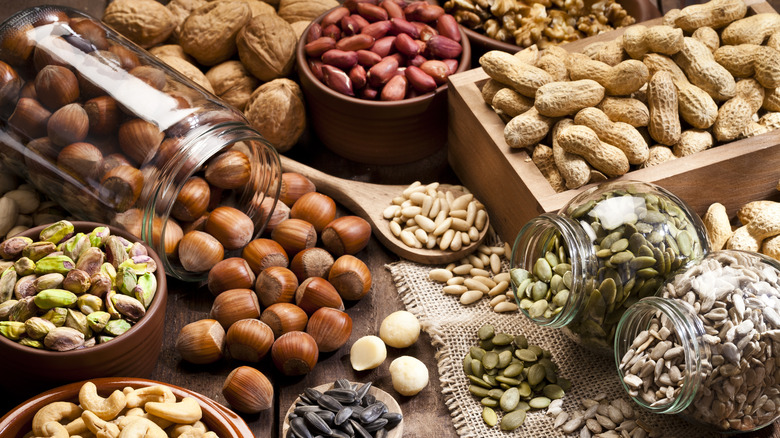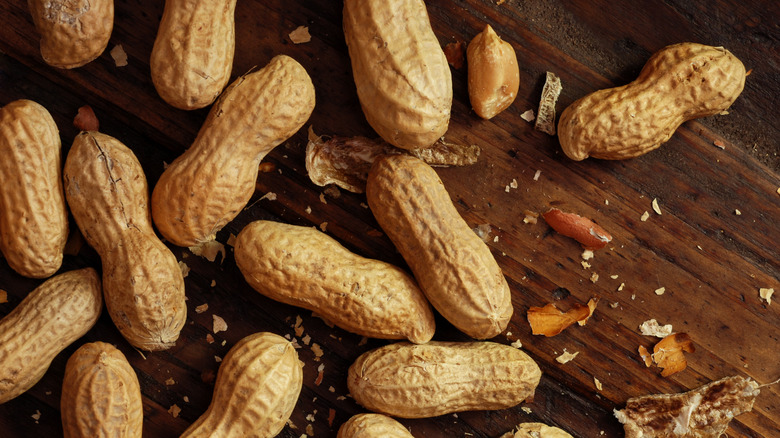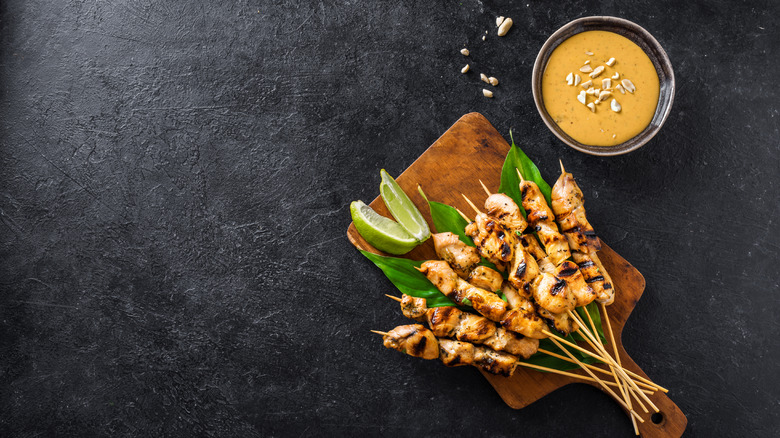The Nut With The Most Protein Per Serving
The human body requires protein to function; it's essential for repairing and creating new cells (per MedlinePlus). A lack of protein can lead to a weakened immune system, muscle loss, and poor hair and skin health, among other things (via Health). The most common food source to get this from is animal products like meat or eggs. But many nuts pack a powerful punch of protein, making them a great option.
Thankfully, the nut with the highest protein content per serving is also the one that is the most available: peanuts. As a note for those with allergies, Harvard Health puts it best: "Peanuts aren't nuts. They are actually legumes ... But like tree nuts, peanuts can be eaten as a filling snack or as a protein-boosting ingredient" (per Harvard Health Publishing).
A one-ounce serving of peanuts contains seven grams of protein. That is nearly equivalent to the amount in one extra large egg. The next top most protein-rich nuts are almonds (six grams), pistachios (5.7 grams), cashews (4.8 grams), and hazelnuts (4.3 grams). However, there is a literal added value to peanuts.
Because tree nuts are more difficult to harvest, they are consequentially more expensive in the store. Peanuts grow in the ground — technically, this is what makes them legumes, but they are categorized as a nut for culinary use — making them both easy to grow and harvest. So not only are they the most protein-rich option, but they are also the most cost-effective.
Peanuts have several other dietary benefits
Peanuts aren't just delivering in the protein category. These ground nuts are a great source of many important vitamins and minerals: folate, niacin, phosphorus, magnesium, thiamine, and vitamin E. They are also high in biotin, a mineral that supports strong hair and nail growth and skin health (via Healthline). They are also an excellent source of dietary fiber. The recommended daily average of dietary fiber for adults is 28 grams (per the American Heart Association). A 1.5-ounce serving of peanuts delivers 3.6 grams of dietary fiber, making them an efficient way to hit the suggested numbers.
Speaking of efficiency, peanuts pack a punch when it comes to energy. That same 1.5-ounce serving translates to about 240 calories. This is approximately the same caloric intake someone gets from consuming just under 2.5 cups of 1% milk, three slices of whole wheat bread, roughly 1.25 cups of white rice, or just under two cups of corn. The energy-dense nature of peanuts means the body gets a lot more for a lot less. Think of it like shopping at Costco.
Incorporate peanuts into your daily cooking routine
It's easy to eat a peanut butter and jelly sandwich, ants on a log, or a handful of salted nuts, but incorporating peanuts into larger meals can often feel like a challenge. Thankfully, the peanut is a versatile ingredient that can be used in a lot of different ways. Whole peanuts and peanut sauce are both excellent additions to pad thais, curries, and chicken and beef satays. Following Food Republic's recipe, a nearly empty peanut butter jar can be transformed into homemade peanut sauce. Adjacent to the sauce, a peanut salad dressing provides a salty-sweet alternative to other cream-based dressings; the gado-gado salad with peanut dressing is a great example.
The nut can also serve as a replacement in recipes that include any of their tree nut cousins. Salads that contain slivered almonds or candied walnuts can have a similar taste with the addition of a peanut's crunch. Replace pine nuts or pistachios in a homemade pesto with peanuts for a different flavor profile. And peanuts are perfect in most desserts — especially ones with chocolate.



